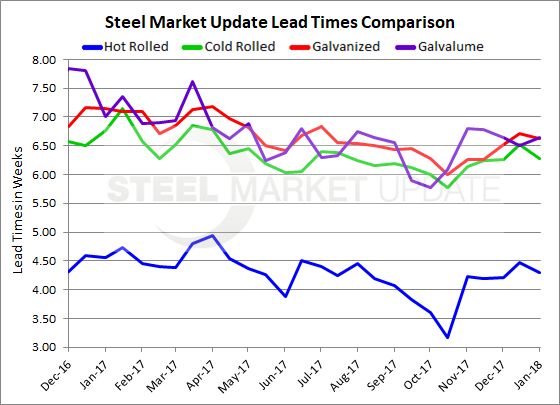SMU Data and Models

Lead Times Dip Despite Mill Price Hikes
Written by Tim Triplett
January 4, 2018
Mill lead times on flat rolled steel extended a bit last month, but defied expectations and returned to prior levels despite mill price hikes in December and January, according to the latest data from Steel Market Update’s market trends questionnaire. Lead time for hot roll remains slightly over four weeks, for cold roll slightly over six weeks, and for galvanized and Galvalume slightly over six and a half weeks.
One of the key indicators tracked by SMU, lead times reflect the activity at the mills and the order levels they are seeing from their customers. At a time when mills are raising prices, one would expect lead times to lengthen, reflecting stronger demand. That does not appear to be the case, at least not yet, as the market moves past the holiday period and shakes out the new mill prices.
Hot rolled lead times averaged 4.29 weeks, down from 4.47 weeks in mid-December. Except for the brief uptick last month, lead times on hot roll have seen little change in the past two months, remaining at about 4.2 weeks since early November.
Cold-rolled lead times averaged 6.27 weeks, down from 6.53 weeks in mid-December, also at about the same level as the past two months.
Galvanized lead times moved down to 6.63 weeks from 6.72 weeks last month. GI lead times have not been this extended since early July. Galvalume lead times, at 6.64 weeks, are up slightly from 6.50 weeks in December.
Note: These lead times are based on the average from manufacturers and steel service centers who participated in this week’s SMU market trends analysis. Our lead times do not predict what any individual may get from any specific mill supplier. Look to your mill rep for actual lead times. Our lead times are meant only to identify trends and changes in the marketplace. To see an interactive history of our Steel Mill Lead Times data, visit our website here.

Tim Triplett
Read more from Tim TriplettLatest in SMU Data and Models

SMU Scrap Survey: Sentiment Indices rise
Both current and future scrap sentiment jumped this month, though survey participants reported responses before key trade news was announced.

SMU Survey: Sentiment splits, buyers have better view of future than the present
SMU’s Steel Buyers’ Sentiment Indices moved in opposite directions this week. After rebounding from a near five-year low in late June, Current Sentiment slipped again. At the same time, Future Sentiment climbed to a four-month high. Both indices continue to show optimism among buyers about their company’s chances for success, but suggest there is less confidence in that optimism than earlier in the year.

SMU scrap market survey results now available
SMU’s ferrous scrap market survey results are now available on our website to all premium members. After logging in at steelmarketupdate.com, visit the pricing and analysis tab and look under the “survey results” section for “ferrous scrap survey” results. Past scrap survey results are also available under that selection. If you need help accessing the survey results […]

SMU flat-rolled market survey results now available
SMU’s latest steel buyers market survey results are now available on our website to all premium members. After logging in at steelmarketupdate.com, visit the pricing and analysis tab and look under the “survey results” section for “latest survey results.” Past survey results are also available under that selection. If you need help accessing the survey results, or if […]

SMU Survey: Sheet lead times stabilize, plate contracts
Mill lead times for sheet products were steady to slightly longer this week compared to our late June market check, while plate lead times contracted, according to steel buyers responding to this week’s market survey.

